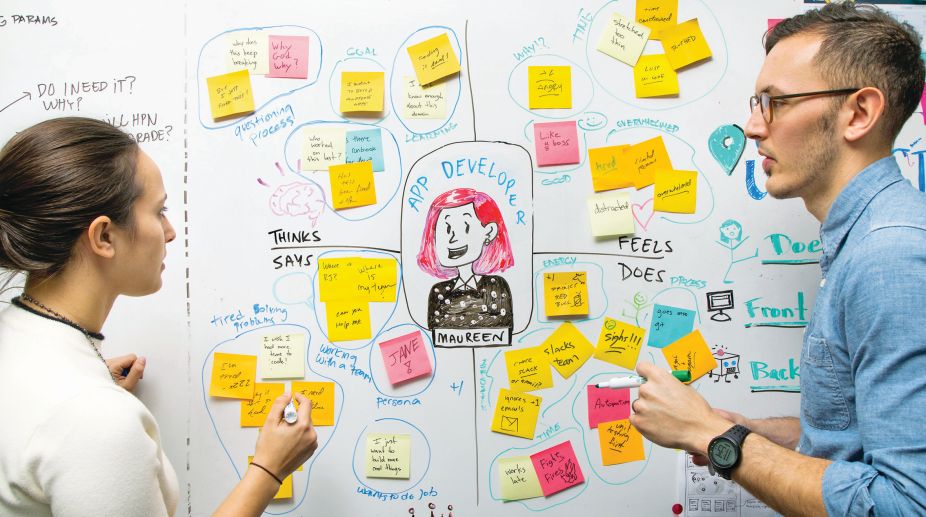Design thinking is the most common buzzword being thrown around nowadays. A human-centred approach to creative problem-solving emphasises on design-driven, iterative prototype based, empathy driven and innovation capacity building.
It is the method of utilising intuition, imagination, experimentation and tangible thinking for ideating great designs.
Advertisement
This is done as a solution provision process for problems that cannot be solved by a single process or formula.
In simple words, the goal of design thinking is to solve problems for the betterment of the society along with creation of desirable and useful experiences, products or services to suit the needs of consumers.
This is quickly making its way into the digital, financial, retail, fashion, healthcare, human resource, banking, education, government, food industry, and all other sectors.
It can be applied in any possible field and does not remain limited to a specific sector. Here are some key aspects of design thinking:
Design thinking methodology calls for a problem driven action-oriented mindset and entails imagination as well as evaluation. Design thinkers formulate several options to generate multiple viewpoints for solving similar issues. This iterative structure includes the receiving feedback and coming up with more feasible solutions to choose from.
Design thinking focuses on the real problems faced by consumers by identifying the latent needs, meeting and surpassing the consumers’ expectations. This involves not only incorporating the contextual features to create an experience with regards to any product or service but also, observations of users needs through design research and draw insights from the same.
Design research, an integral part of behaviour, and habits regularly and interact with them directly, you can easily address their grievances and solve their problems, besides adding value to your business offerings.
Well followed design thinking process should lead to a brief and a design that is simplicity, ease of use, attractiveness, responsiveness to consumer needs, and seamless user-experience.
Design thinking as a process can be applied in various business processes that make it the most effective methodology. The innate ability of design thinking resulting in innovation capacity building makes any business future proof. It can help bring coherence into the scattered digital world.
This is why forward-thinking corporations such as Apple, SAP, General Electric, Microsoft, Procter and Gamble, Nike, Pepsi, IBM, and Disney have embraced design thinking so that they can redefine their way of innovation and drive business growth. Startups businesses like Uber and Airbnb are also reaping the benefits of design thinking to outshine their peers.
Any business comes with new challenges to be faced in every new situation. Design thinking helps in disintegrating the problems into minor solvable ones with a range of iterative solutions.
This is an important element for the success of your business as it helps you resonate with your users and win their confidence by creating an emotional connect and solving the problem.
Implementing design thinking can be a smart money saving tool, since the problems are identified to near perfection, and hence leads to less redundant work. It results in more incoming revenue. By shifting your focus from business-centric solutions to user-driven designs, you can make your company more organised and innovative.
Fortune 500 companies are hiring chief design officers and investing heavily in design and innovation centers. Professional services firms, too, have joined the fray. In 2013, Accenture acquired Fjord, a leading design firm, while PwC snapped up BGT, a digital creative consultancy.
In 2015, McKinsey & Co purchased Lunar, a Silicon Valley-based design firm. In October 2017, Indian software giant Wipro acquired design agency Cooper, adding to its 2015 purchase of Designit.
When design principles are applied to strategy and innovation the success rate for innovation dramatically improves. Design thinking has its own share of challenges.
When dealing with a tricky situation, you generally tend to react spontaneously, and therein lies the problem. If you intend to resolve a difficult problem, you should not entertain your impulsive urge as it is the greatest obstacle to the success of your design thinking project.
Instead of reacting impulsively, you should patiently analyse and understand the problem at hand before ideating the probable solutions to the problem. Group think is yet another obstacle that occurs when your team members make unanimous decisions as a group instead of indulging in innovative decision-making.
In order to eliminate poor decision-making, you should provide your team members with ample scope to express themselves. None of the team members should be allowed to control the brainstorming sessions.
Design thinking today, is the magic potion for survival in the competitive world. In order to gain a competitive edge in the market with greater innovation and creativity, the power of design thinking cannot be ignored. Design thinking is the crucial driving force for small and large businesses alike at the present time.
The advocates of design thinking assert that this approach enables businesses to introduce innovations to consumers on a regular basis to create more customer value.
Therefore, if you want to outperform your business competitors, if you want your business to be future proof, you should make designing thinking an important part of your business strategy.
The writer is vice-chancellor, World University of Design











